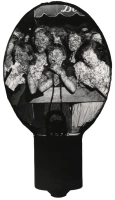
Erich Salomon, Carnaval de Munich, 1925 (411.1983)

Erich Salomon, Queen Wilhelmina, Princess Juliana and Prince Bernard, Amsterdam, 1938 (409.1983)

Erich Salomon, Dutch Deputies looking at Erich Salomon’s book “Famous Contemporaries During Unguarded Moments,” The Hague, 1935 (133.1986)

Berliner Illustrirte Zeitung, September 14, 1930 (2007.87.10)

Berliner Illustrirte Zeitung, June 19, 1932 (2007.87.14)
Erich Franz Emil Salomon was born on April 28, 1886 in Berlin and grew up with his four siblings in the city where he was born. Although he grew up in a prosperous family, Salomon must have experienced difficult times during his adolescent years; both his sisters died from tuberculosis, his brother committed suicide, and his father passed away unexpectedly while giving a speech. In the years that followed, Salomon decided to study law like his father.
During World War I Salomon, a sergeant in the German army, was imprisoned by the French for three-and-a-half years. He returned to Germany to find that his mother had taken her own life. Due to the difficult financial times in Germany and as well as diminishing family capital, Salomon was forced to find a job to support his wife and child. It was not until the 1920s that Salomon became involved in photography. While working closely with photographers on a project in the Publicity Department of publishing house Ullstein, which printed the illustrated weekly Berliner Illustrirte Zeitung among others, Salomon decided it would be more profitable to become a photographer.
In the late 1920s Salomon taught himself to photograph and sold the pictures he took of his family trips to pay for it. During this time he started documenting big trials by photographing through a hole he made in his hat. His career as a photographer officially began when some of these photographs were published in Berliner Illustrirte Zeitung. In 1929 Salomon secretly (and illegally) photographed inside the British Supreme Court; the images caused a stir when they were published six years later. Over the course of his career, Salomon continued to photograph scenes, people, and locations, often of political significance, at meaningful and unguarded moments, earning him the nickname “King of Indiscretion.”
Salomon’s oeuvre can be divided into two periods: his work from before and after World War II. In the early 1930s he was considered the official photographer of the German republic. After the war Salomon’s work reflected the political game that went on prior to and during the power that was seized by the Nationalsozialistische Deutsche Arbeiterpartei (NSDAP), Hitler’s Nazi party. Not only were Salomon’s photographs used to understand the extent of the international political failing that escalated into the large-scale atrocities, but the images were also used to analyze the political and diplomatic characteristics of the people that he documented during the war.
In 1933 the political situation changed dramatically in Germany when NSDAP became part of the government. During the Salomons’ visit to The Hague that year, where they stayed with the parents of Salomon’s wife, they decided not to return to Berlin. Their oldest son Otto Erich (who later changed his name to Peter Hunter) finished his study in law and moved to London in 1934. After two years of hiding in the Netherlands, Salomon and his family were betrayed in 1944. A few months later he was deported to Westerbork, where he was temporarily united with his wife and youngest son Dirk. On July 7, 1944 they died in Auschwitz.

